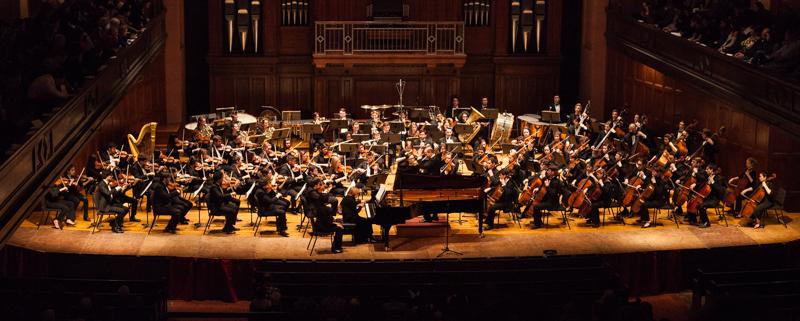Duphil, Oberlin Orchestra Pack Finney Chapel
Photo by Bryan Rubin, Photo editor
Raphael Jiménez conducts the Oberlin Orchestra in Finney Chapel Saturday. The Orchestra’s program featured Rachmaninoff’s Piano Concerto No. 2 in C Minor and Professor of Composition Stephen Hartke’s Symphony No. 4.
March 4, 2016
t is unquestionable that Oberlin’s conservatory of music is exceptional. However, it is still thrilling to be able to experience it in person. On Saturday night, the Finney Chapel stage was packed with the Conservatory students of the Oberlin Orchestra ready to play in their first spring concert of the semester. This performance was conducted by Director of Conducting and Ensembles Raphael Jiménez and featured Rachmaninoff ’s Piano Concerto No. 2 in C Minor as well as Oberlin Professor of Composition Stephen Hartke’s Symphony No. 4.
Professor of Piano Monique Duphil joined the orchestra for its performance of the Rachmaninoff. Duphil has been performing since she was 15 years old, has played in more than 50 countries across five continents and has been teaching at Oberlin since 1992. From the beginning of the piece, it was abundantly clear that conductor, soloist and orchestra were working in perfect synchronicity. The main motif of the piece was built on the interplay of piano and orchestra. Melodies were clean and haunting throughout, but much of the piece’s richness came out when the orchestra fell silent, giving the piano the room to shine clearly. As the piece progressed, clever moments of call and response between the piano melody and the orchestra added dimension to the piece.
The program promised that Rachmaninoff ’s concerto would feature “dazzling musical acrobatics with fiendish arpeggios” and “pianistic fireworks.” Duphil delivered on all counts. The orchestra, too, delivered on the program’s promises. Every musician shone both individually and as part of the collective. Playing in perfect harmony with one another, it was hard to believe that there were so many musicians on the stage.
After the intermission, the orchestra moved on to Hartke’s Symphony No. 4 for Organ, Orchestra and Soprano. The organ part was performed by Jonathan William Moyer, who has performed throughout the United States, Europe and Japan and received an Artist Diploma from Oberlin’s Conservatory graduate program in 2012. He also oversees the music program of the Church of the Covenant in Cleveland. The soprano soloist was Conservatory junior Amber Monroe, fresh off her performance as Harriet Tubman in the opera Harriet Tubman: When I Crossed that Line to Freedom.
Hartke’s symphony immediately differentiated itself from the concerto with its use of loud, visceral sounds that could be physically felt as well as heard. Hartke’s symphony celebrated individual instruments and displayed a wide variety of textures.
The organ melodies thrilled. Moyer played complex passages with ease, introducing melodies that the rest of the orchestra soon picked up and built upon. The composer also took advantage of the full range of the organ, leading to great elasticity in the solo part. The one disappointing note of the evening was that the music seemed somewhat discordant at points in the first and second movements. However, these moments were few and far between, and by the third movement, the orchestra returned to the triumphant heights it reached in the concert’s first half.
The symphony’s third movement was characterized by a stunningly technical performance from Amber Monroe, who sang an English translation of Federico García Lorca’s poem The Sleepwalking Ballad. The words of the poem are filled with gripping surrealist imagery, and the music added depth to this dreamlike narrative. The addition of purely musical stanzas built up by the orchestra while the soprano was silent added nuanced interpretation to the poem.
At the end of the piece, Hartke, the soloists and the orchestra received a standing ovation.
Jiménez conducted the Oberlin Orchestra in a brilliant performance spanning techniques and time periods. It was a true privilege to experience the impressive range of sounds produced by students, graduates and faculty members.

























